[English] 日本語
 Yorodumi
Yorodumi- PDB-1xow: Crystal structure of the human androgen receptor ligand binding d... -
+ Open data
Open data
- Basic information
Basic information
| Entry | Database: PDB / ID: 1xow | ||||||
|---|---|---|---|---|---|---|---|
| Title | Crystal structure of the human androgen receptor ligand binding domain bound with an androgen receptor NH2-terminal peptide, AR20-30, and R1881 | ||||||
 Components Components |
| ||||||
 Keywords Keywords | TRANSCRIPTION / crystal structure / human androgen receptor ligand binding domain / androgen receptor NH2-terminal peptide AR20-30 / R1881 | ||||||
| Function / homology |  Function and homology information Function and homology informationmale somatic sex determination / prostate induction / lateral sprouting involved in mammary gland duct morphogenesis / male genitalia morphogenesis / regulation of developmental growth / POU domain binding / positive regulation of integrin biosynthetic process / tertiary branching involved in mammary gland duct morphogenesis / animal organ formation / androgen binding ...male somatic sex determination / prostate induction / lateral sprouting involved in mammary gland duct morphogenesis / male genitalia morphogenesis / regulation of developmental growth / POU domain binding / positive regulation of integrin biosynthetic process / tertiary branching involved in mammary gland duct morphogenesis / animal organ formation / androgen binding / cellular response to testosterone stimulus / regulation of systemic arterial blood pressure / Leydig cell differentiation / epithelial cell differentiation involved in prostate gland development / positive regulation of epithelial cell proliferation involved in prostate gland development / prostate gland epithelium morphogenesis / prostate gland growth / epithelial cell morphogenesis / membraneless organelle assembly / RNA polymerase II general transcription initiation factor binding / positive regulation of insulin-like growth factor receptor signaling pathway / positive regulation of transcription by RNA polymerase III / morphogenesis of an epithelial fold / cellular response to steroid hormone stimulus / positive regulation of intracellular estrogen receptor signaling pathway / androgen receptor signaling pathway / seminiferous tubule development / RUNX2 regulates osteoblast differentiation / nuclear steroid receptor activity / mammary gland alveolus development / cellular response to estrogen stimulus / estrogen response element binding / nuclear receptor-mediated steroid hormone signaling pathway / single fertilization / RNA polymerase II core promoter sequence-specific DNA binding / regulation of protein localization to plasma membrane / intracellular receptor signaling pathway / estrogen receptor signaling pathway / steroid binding / insulin-like growth factor receptor signaling pathway / HSP90 chaperone cycle for steroid hormone receptors (SHR) in the presence of ligand / epithelial cell proliferation / negative regulation of extrinsic apoptotic signaling pathway / RNA polymerase II transcription regulatory region sequence-specific DNA binding / positive regulation of cell differentiation / SUMOylation of intracellular receptors / molecular condensate scaffold activity / Activated PKN1 stimulates transcription of AR (androgen receptor) regulated genes KLK2 and KLK3 / beta-catenin binding / Nuclear Receptor transcription pathway / positive regulation of miRNA transcription / transcription coactivator binding / male gonad development / multicellular organism growth / nuclear receptor activity / negative regulation of epithelial cell proliferation / cell-cell signaling / MAPK cascade / ATPase binding / DNA-binding transcription activator activity, RNA polymerase II-specific / spermatogenesis / in utero embryonic development / molecular adaptor activity / RNA polymerase II-specific DNA-binding transcription factor binding / transcription by RNA polymerase II / DNA-binding transcription factor activity, RNA polymerase II-specific / transcription cis-regulatory region binding / positive regulation of MAPK cascade / Ub-specific processing proteases / nuclear speck / RNA polymerase II cis-regulatory region sequence-specific DNA binding / DNA-binding transcription factor activity / signaling receptor binding / negative regulation of cell population proliferation / positive regulation of cell population proliferation / chromatin binding / positive regulation of gene expression / chromatin / positive regulation of DNA-templated transcription / enzyme binding / negative regulation of transcription by RNA polymerase II / signal transduction / positive regulation of transcription by RNA polymerase II / protein-containing complex / zinc ion binding / nucleoplasm / nucleus / plasma membrane / cytosol / cytoplasm Similarity search - Function | ||||||
| Biological species |  Homo sapiens (human) Homo sapiens (human) | ||||||
| Method |  X-RAY DIFFRACTION / X-RAY DIFFRACTION /  MOLECULAR REPLACEMENT / Resolution: 1.8 Å MOLECULAR REPLACEMENT / Resolution: 1.8 Å | ||||||
 Authors Authors | He, B. / Gampe Jr., R.T. / Kole, A.J. / Hnat, A.T. / Stanley, T.B. / An, G. / Stewart, E.L. / Kalman, R.I. / Minges, J.T. / Wilson, E.M. | ||||||
 Citation Citation |  Journal: Mol.Cell / Year: 2004 Journal: Mol.Cell / Year: 2004Title: Structural basis for androgen receptor interdomain and coactivator interactions suggests a transition in nuclear receptor activation function dominance Authors: He, B. / Gampe Jr., R.T. / Kole, A.J. / Hnat, A.T. / Stanley, T.B. / An, G. / Stewart, E.L. / Kalman, R.I. / Minges, J.T. / Wilson, E.M. | ||||||
| History |
|
- Structure visualization
Structure visualization
| Structure viewer | Molecule:  Molmil Molmil Jmol/JSmol Jmol/JSmol |
|---|
- Downloads & links
Downloads & links
- Download
Download
| PDBx/mmCIF format |  1xow.cif.gz 1xow.cif.gz | 69.7 KB | Display |  PDBx/mmCIF format PDBx/mmCIF format |
|---|---|---|---|---|
| PDB format |  pdb1xow.ent.gz pdb1xow.ent.gz | 50.4 KB | Display |  PDB format PDB format |
| PDBx/mmJSON format |  1xow.json.gz 1xow.json.gz | Tree view |  PDBx/mmJSON format PDBx/mmJSON format | |
| Others |  Other downloads Other downloads |
-Validation report
| Summary document |  1xow_validation.pdf.gz 1xow_validation.pdf.gz | 704.1 KB | Display |  wwPDB validaton report wwPDB validaton report |
|---|---|---|---|---|
| Full document |  1xow_full_validation.pdf.gz 1xow_full_validation.pdf.gz | 706 KB | Display | |
| Data in XML |  1xow_validation.xml.gz 1xow_validation.xml.gz | 14 KB | Display | |
| Data in CIF |  1xow_validation.cif.gz 1xow_validation.cif.gz | 19.4 KB | Display | |
| Arichive directory |  https://data.pdbj.org/pub/pdb/validation_reports/xo/1xow https://data.pdbj.org/pub/pdb/validation_reports/xo/1xow ftp://data.pdbj.org/pub/pdb/validation_reports/xo/1xow ftp://data.pdbj.org/pub/pdb/validation_reports/xo/1xow | HTTPS FTP |
-Related structure data
| Related structure data |  1xq3C  2ao6C 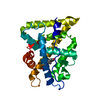 1i37S S: Starting model for refinement C: citing same article ( |
|---|---|
| Similar structure data |
- Links
Links
- Assembly
Assembly
| Deposited unit | 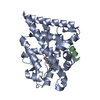
| ||||||||||
|---|---|---|---|---|---|---|---|---|---|---|---|
| 1 |
| ||||||||||
| Unit cell |
|
- Components
Components
| #1: Protein | Mass: 29046.074 Da / Num. of mol.: 1 / Fragment: ligand binding domain Source method: isolated from a genetically manipulated source Details: inhibited by r1881 / Source: (gene. exp.)  Homo sapiens (human) / Gene: Ar, Nr3c4 / Plasmid: pET15b / Species (production host): Escherichia coli / Production host: Homo sapiens (human) / Gene: Ar, Nr3c4 / Plasmid: pET15b / Species (production host): Escherichia coli / Production host:  |
|---|---|
| #2: Protein/peptide | Mass: 1267.413 Da / Num. of mol.: 1 / Fragment: N-terminal FXXLF domain / Source method: obtained synthetically Details: decapeptide of human AR NH2-terminal residues 20-30 References: UniProt: P10275 |
| #3: Chemical | ChemComp-R18 / ( |
| #4: Water | ChemComp-HOH / |
-Experimental details
-Experiment
| Experiment | Method:  X-RAY DIFFRACTION / Number of used crystals: 1 X-RAY DIFFRACTION / Number of used crystals: 1 |
|---|
- Sample preparation
Sample preparation
| Crystal | Density Matthews: 2.02 Å3/Da / Density % sol: 38.5 % |
|---|---|
| Crystal grow | Temperature: 293 K / Method: vapor diffusion, hanging drop / pH: 7.5 Details: 100mM BTP, 0.6-1.2M Li2SO4, pH 7.5, VAPOR DIFFUSION, HANGING DROP, temperature 293K |
-Data collection
| Diffraction | Mean temperature: 93 K |
|---|---|
| Diffraction source | Source:  ROTATING ANODE / Type: RIGAKU RU200 / Wavelength: 1.5418 Å ROTATING ANODE / Type: RIGAKU RU200 / Wavelength: 1.5418 Å |
| Detector | Type: MARRESEARCH / Detector: IMAGE PLATE / Date: Oct 26, 2003 |
| Radiation | Protocol: SINGLE WAVELENGTH / Monochromatic (M) / Laue (L): M / Scattering type: x-ray |
| Radiation wavelength | Wavelength: 1.5418 Å / Relative weight: 1 |
| Reflection | Resolution: 1.8→50 Å / Num. all: 22123 / Num. obs: 22123 / % possible obs: 90.4 % / Observed criterion σ(I): 0 / Biso Wilson estimate: 31 Å2 / Rmerge(I) obs: 0.041 / Net I/σ(I): 37.8 |
| Reflection shell | Resolution: 1.8→1.86 Å / Rmerge(I) obs: 0.34 / Mean I/σ(I) obs: 2 / Num. unique all: 1011 / % possible all: 42 |
- Processing
Processing
| Software |
| ||||||||||||||||||||||||||||||||||||
|---|---|---|---|---|---|---|---|---|---|---|---|---|---|---|---|---|---|---|---|---|---|---|---|---|---|---|---|---|---|---|---|---|---|---|---|---|---|
| Refinement | Method to determine structure:  MOLECULAR REPLACEMENT MOLECULAR REPLACEMENTStarting model: 1I37 Resolution: 1.8→22 Å / Rfactor Rfree error: 0.005 / Data cutoff high absF: 1404666.74 / Data cutoff low absF: 0 / Isotropic thermal model: RESTRAINED / Cross valid method: THROUGHOUT / σ(F): 0
| ||||||||||||||||||||||||||||||||||||
| Solvent computation | Solvent model: FLAT MODEL / Bsol: 53.0545 Å2 / ksol: 0.383466 e/Å3 | ||||||||||||||||||||||||||||||||||||
| Displacement parameters | Biso mean: 32.8 Å2
| ||||||||||||||||||||||||||||||||||||
| Refine analyze |
| ||||||||||||||||||||||||||||||||||||
| Refinement step | Cycle: LAST / Resolution: 1.8→22 Å
| ||||||||||||||||||||||||||||||||||||
| Refine LS restraints |
| ||||||||||||||||||||||||||||||||||||
| LS refinement shell | Resolution: 1.8→1.91 Å / Rfactor Rfree error: 0.033 / Total num. of bins used: 6
| ||||||||||||||||||||||||||||||||||||
| Xplor file |
|
 Movie
Movie Controller
Controller



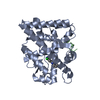
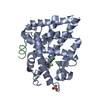

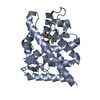
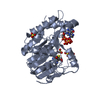

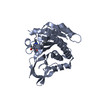
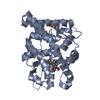


 PDBj
PDBj







